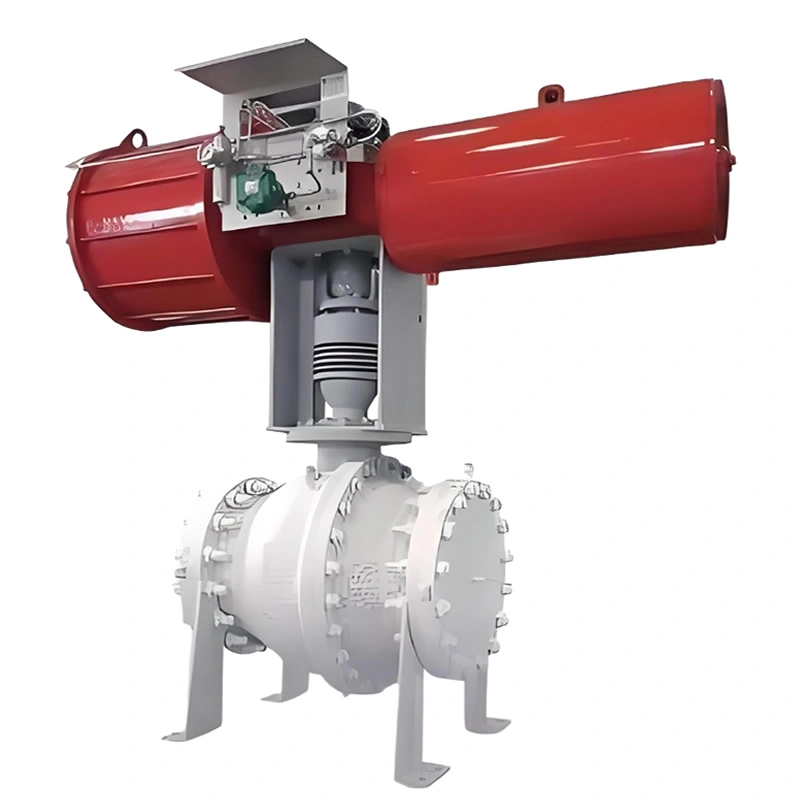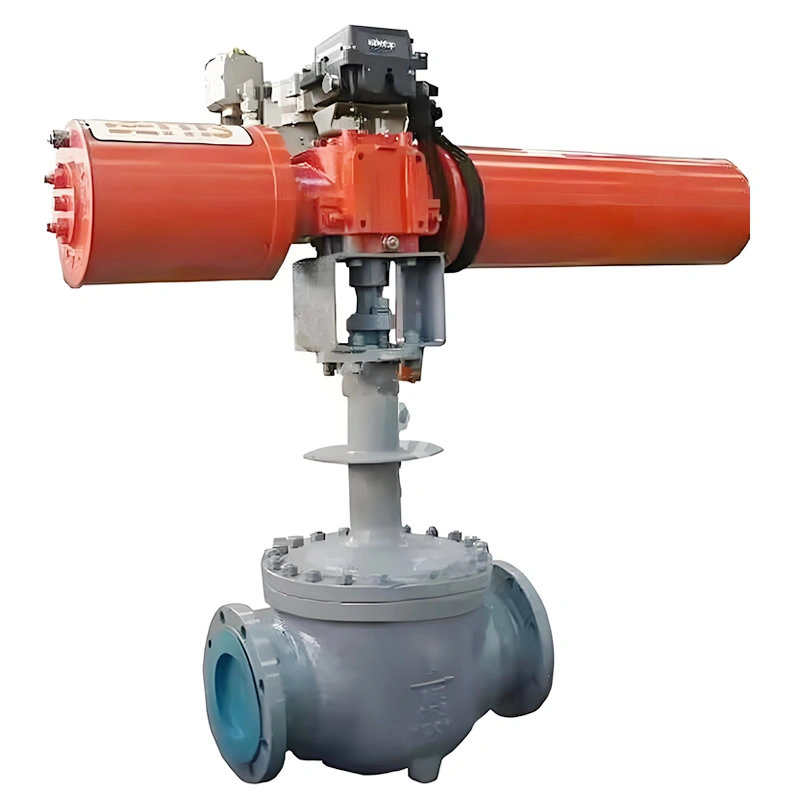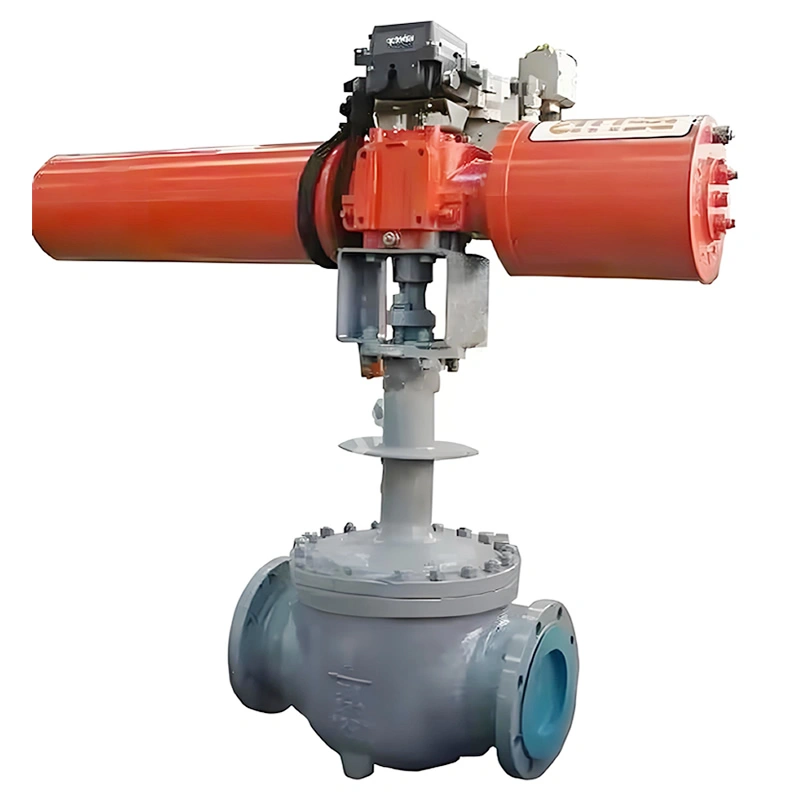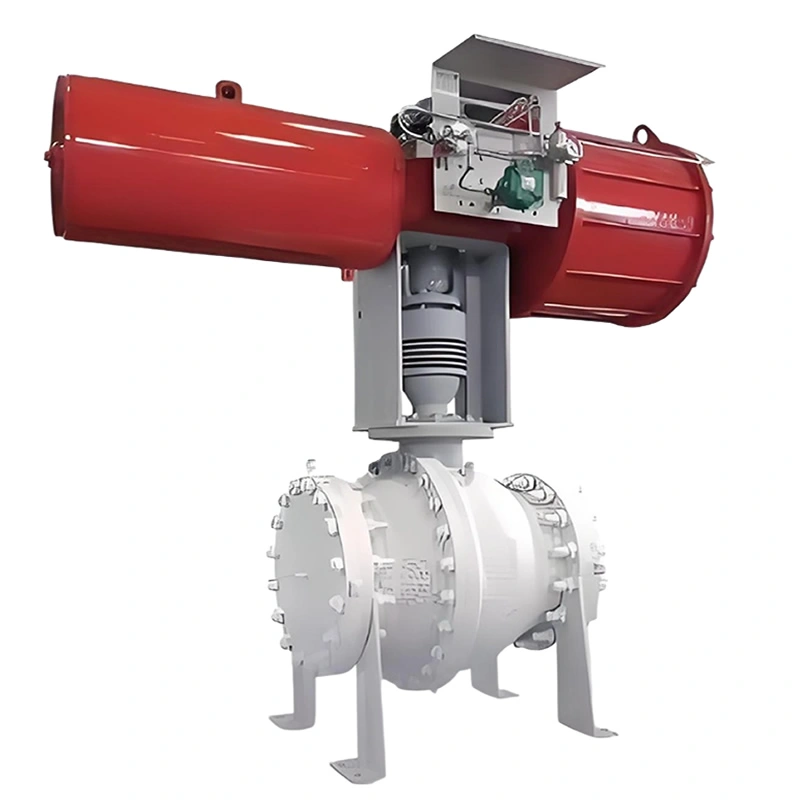- NPS 1/2″~56″
- Control
- General
- China
- OEM, ODM, OBM
- Low Temperature
- TIANYU
- Cryogenic Top Entry Ball Valve
- Size: NPS1/2″~56″
- Carbon Steel, Stainless Steel, Duplex, Inconel, Monel
- Class 150~Class 2500
- AP16DBS 5351ASME B1634SO17292
- Manual, Worm Gear, Electric Actuator, Pneumatic Actuator
- -196°C~550°C
- ASME B16.10 API6D
NEWWAY DN500 900LB Pneumatic Cryogenic Top Entry Ball Valve: API 6D-Compliant Solution for Extreme Low-Temperature Industrial Flow Control
I. Product Overview
NEWWAY DN500 900LB pneumatic cryogenic top entry ball valve, engineered to meet API 6D standards, is a high-performance flow control solution designed for extreme low-temperature industrial applications. This valve combines a top-entry structural design with advanced cryogenic-resistant technologies, enabling reliable operation in harsh environments where media such as liquefied natural gas (LNG), liquid nitrogen, and liquid oxygen are handled at temperatures as low as -196℃. The top-entry configuration simplifies maintenance, while the integration of pneumatic actuation ensures rapid, automated flow control. Crafted from premium materials and equipped with specialized sealing systems, this valve is a critical component in industries such as LNG processing, air separation, and low-temperature chemical engineering, where precision, safety, and durability under cryogenic conditions are paramount.
II. Key Attribute Specifications
A. Dimensional and Pressure Parameters
Nominal Diameter: DN500 (20-inch), catering to large-flow pipeline requirements in industrial cryogenic systems. In LNG transfer applications, a DN500 valve can handle flow rates exceeding 1000 m³/h, ensuring efficient media distribution.
Pressure Rating: 900LB (equivalent to Class 900, approximately 15.5MPa working pressure), compliant with high-pressure cryogenic storage and transportation systems. This rating ensures the valve can withstand the rigorous pressure demands of LNG terminals and large-scale air separation units.
Temperature Range: Engineered to operate continuously between -196℃ (boiling point of liquid nitrogen) and 100℃. Special thermal insulation layers are integrated to minimize cold energy loss and prevent external moisture condensation on the valve surface, maintaining operational stability in extreme temperature differentials.
B. Material Composition
Valve Body and Ball:
For standard cryogenic applications, low-temperature carbon steel (ASTM A352 LCB) is used, offering exceptional toughness at sub-zero temperatures. LCB steel undergoes quenching and tempering to achieve a Charpy impact energy of ≥27J at -46℃, preventing cold brittleness.
In corrosive cryogenic environments (e.g., LNG with high sulfur content), stainless steel (ASTM A351 CF8M/316L) is employed. Its molybdenum content enhances resistance to pitting and crevice corrosion, ensuring longevity in aggressive media.
Sealing Components:
Primary seals utilize polytetrafluoroethylene (PTFE) with spring pre-loading. PTFE retains elasticity at low temperatures and exhibits low friction, ensuring a reliable seal despite thermal contraction.
For high-pressure cryogenic scenarios, metal-to-metal seals (e.g., Inconel 625 coating) are available, withstanding high pressure differentials and offering superior wear resistance.
C. Structural and Operational Features
Top-Entry Design: The valve body features a top-mounted access flange, allowing internal components (ball, stem, seals) to be removed and replaced without disconnecting pipeline flanges. This design reduces maintenance downtime by over 50% compared to side-entry valves, critical for minimizing production losses in continuous-process industries.
Stem Sealing: A multi-layer sealing structure combines graphite packing and O-rings, preventing cryogenic media leakage and external air ingress. This design maintains the low-temperature environment inside the valve and ensures operational safety.
Actuation: Equipped with a pneumatic actuator (double-acting or spring-return), enabling rapid 90° rotation for quick flow adjustment. For safety-critical applications (e.g., LNG emergency shutdown), spring-return actuators provide fail-safe closure upon air supply loss.
The Cryogenic Top-Entry Ball Valve, as an important on/off component in the cryogenic pipeline system, is an important part of the petrochemical industry, air separation, and natural gas industry. The structure of Top-Entry Ball Valve can realize online maintenance, and is suitable for low-temperature liquid or gas media, such as liquefied natural gas (LNG), liquefied petroleum gas (LPG), liquid hydrogen, liquid oxygen, ethylene and other conditions. Compared with the Side-Entry ball valve under the same conditions, Top-Entry Ball Valve is more convenient to maintain with a wider scope of application, and is more common.
Size:NPS1/2″~56″
Temperature: -196°C~550°C
Pressure:Class 150~Class 2,500
Materials:Carbon Steel, Stainless Steel, Duplex, Inconel, Monel, Bronze, Titanium Alloy
Standard:AP16DBS 5351ASME B1634SO17292
Face to Face: ASME B16.10API6D
End Connection:ASME B16.5ASME B1647,ASME B1625ASME B16.11
Test Standard: ISO 5208,API6DAPI598
Operators:Manual, Worm Gear, Electric Actuator, Pneumatic Actuator
Product Overview
III. Feature Description
A. Top-Entry Design for Efficient Maintenance
The top-entry configuration revolutionizes maintenance workflows. Traditional side-entry valves require pipeline disassembly to access internal components, a time-consuming process that risks media loss and extended downtime. In contrast, NEWWAY’s top-entry valve allows maintenance personnel to lift the bonnet assembly directly after removing the top flange bolts. In an LNG receiving terminal, this design reduces valve maintenance time from 8 hours to 2 hours, ensuring rapid return to operation. The top-entry design also eliminates the need to drain cryogenic media from pipelines during maintenance, preserving valuable resources and reducing environmental impact.
B. Cryogenic-Resistant Sealing Technology
At ultra-low temperatures, material contraction and seal hardening pose significant challenges to sealing integrity. NEWWAY’s cryogenic ball valve addresses this with a dual-stage sealing system:
Primary Seal: PTFE with spring pre-load compensates for thermal contraction, maintaining continuous contact between the seal and ball. In -196℃ testing, this seal achieves a leakage rate of <1×10⁻⁶ cm³/s, far below API 6D requirements.
Secondary Metal Backup Seal: Activates in extreme scenarios (e.g., fire or seal degradation), preventing catastrophic media release. This redundancy ensures safety in high-risk environments such as LNG processing plants.
C. API 6D Compliance and Safety Assurance
As an API 6D-certified product, the valve undergoes rigorous testing to ensure reliability:
Pressure Testing: Hydrostatic testing at 1.5× rated pressure (23.25MPa for 900LB) and pneumatic testing at 1.1× rated pressure verify structural integrity.
Cryogenic Performance Testing: The valve is cooled to -196℃ using liquid nitrogen, subjected to 100+ open/close cycles to validate operational stability.
Fire-Safe Design (Optional): API 607-certified variants use metal backup seals and graphite packing to maintain temporary sealing during fire exposure, reducing explosion risks in flammable cryogenic applications.
D. Material Toughness at Low Temperatures
Material selection is critical for cryogenic performance:
LCB Steel: Quenching and tempering refine the grain structure, enhancing impact toughness. At -46℃, Charpy impact energy exceeds 40J (vs. 27J standard), preventing brittle failure.
316L Stainless Steel: Molybdenum content (2-3%) resists pitting in chloride-rich environments (e.g., wet LNG), while maintaining toughness at -196℃.
IV. Manufacturing Processes
A. Low-Temperature Material Processing
Heat Treatment of LCB Steel: Valve bodies and balls undergo quenching (890-920℃, water-cooled) and tempering (600-650℃, air-cooled) to eliminate internal stresses and optimize microstructure for low-temperature toughness.
Cold Working of Stainless Steel: 316L components undergo cold extrusion to enhance surface hardness and dimensional accuracy, followed by solution annealing (1050-1100℃) to restore corrosion resistance.
B. Precision Machining of Top-Entry Structure
Valve Body Machining: 5-axis CNC machines shape the top-entry flange and internal flow channels, with flatness tolerance <0.05mm to ensure bonnet sealing.
Ball and Stem Assembly: The ball and stem are connected via spline or keyway, with coaxiality tolerance ≤0.02mm to ensure smooth rotation and uniform seat contact.
Seal Surface Lapping: Ball and seat sealing surfaces are lapped to Ra ≤0.8μm, ensuring tight sealing under high-pressure, low-temperature conditions.
C. Cryogenic Testing and Validation
Deep-Cooling Treatment: Assembled valves are immersed in liquid nitrogen (-196℃) for 4 hours to simulate extreme conditions, detecting material defects or structural deformations.
Leakage Testing: Helium mass spectrometry measures leakage rates <5×10⁻¹⁰ Pa·m³/s, meeting strict cryogenic sealing demands.
Cycle Testing: 1000+ open/close cycles at -196℃ verify seal durability and actuator reliability.
Valve Details
V. Product Advantages
A. Uninterrupted Operation in Cryogenic Environments
The combination of low-temperature-resistant materials, advanced sealing, and rigorous testing ensures stable operation in -196℃ environments. In an LNG storage tank application, the valve has operated continuously for 5 years without seal failure, reducing maintenance costs and downtime.
B. Efficient Maintenance with Top-Entry Design
Top-entry access eliminates pipeline disassembly during maintenance. In a large air separation plant, replacing a valve seat takes just 2 hours, minimizing liquid oxygen/nitrogen loss and ensuring production continuity.
C. API Certification for Global Compliance
API 6D certification ensures the valve meets international standards, enabling seamless integration into global projects (e.g., LNG export terminals). This certification builds customer confidence in harsh environments.
D. Enhanced Safety with Fire-Safe Options
Optional API 607 fire-safe design provides an extra layer of protection in flammable cryogenic applications (e.g., LNG), preventing catastrophic leakage during fires.
Application
VI. Product Applications
A. LNG Industry
LNG Receiving Terminals: Controls LNG unloading and distribution on storage tank outlets and unloading arms. The top-entry design ensures rapid maintenance, while cryogenic sealing prevents LNG leakage.
LNG Transportation Pipelines: Regulates flow in medium- to high-pressure LNG pipelines, withstanding pressure fluctuations and ensuring safe media transport.
B. Air Separation Equipment
Liquid Oxygen/Nitrogen Systems: Manages flow in air separation units, with LCB steel and reliable sealing ensuring product purity and system stability.
Cold Box Pipelines: Operates in ultra-low-temperature cold boxes, withstanding frequent flow adjustments and maintaining separation process efficiency.
C. Low-Temperature Chemical Engineering
Refrigerant Handling: Controls cryogenic refrigerants (ethylene, propylene) in chemical plants, with 316L stainless steel resisting corrosion and ensuring refrigeration system efficiency.
Low-Temperature Reaction Processes: Regulates material feeding in -100℃ hydrogenation reactors, with precise flow control maintaining reaction stability.
D. Energy and Storage
Cryogenic Energy Storage: Manages liquid air charging/discharging in energy storage systems, with top-entry design and cryogenic performance supporting long-term operation.
Aerospace Propellant Systems: Controls liquid hydrogen/oxygen flow in ground test facilities, with strict leakage control ensuring test safety.
NEWWAY DN500 900LB pneumatic cryogenic top entry ball valve: API 6D-compliant, reliable in -196℃, easy to maintain, safe. Ideal for LNG, air separation, low-temperature chemicals.Customize with: 316L for corrosion, Inconel seals for extreme temps, explosion-proof actuators, extended bonnets for insulation. Tailored to your cryogenic system’s media, pressure, control needs.




